Halo 5: Guardians Review
Halo 5: Guardians
Multiplayer review update: Fresh impressions on public servers
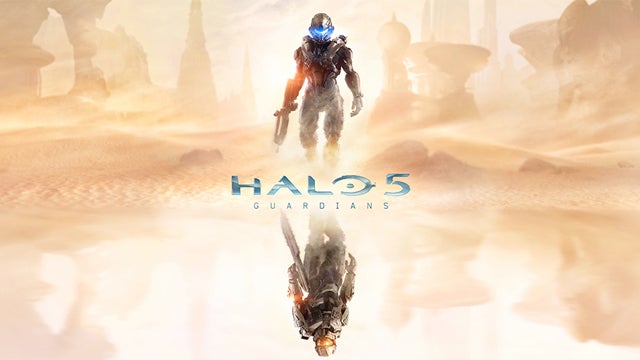
Verdict
Pros
- Classic Halo combat
- New co-op and movement mechanics blend in well
- Amazing set-pieces and alien worlds
- The Xbox One's most awesome visuals
- Brilliant and addictive Arena and Warzone modes
Cons
- Some really clumsy sequences
- Story will be divisive
Key Specifications
- Review Price: £39.95
Exclusive to Xbox One
Halo 5: Guardians release date – October 27
Halo 5: Guardians Multiplayer Review
First, the good news. Halo 5’s servers have been up and running for a week now, and there’s no sign of any of the issues that afflicted The Master Chief Collection at and for a good while after launch. Matchmaking seems smooth and we’ve rarely had to wait for more than few minutes for a game to start. Loading times aren’t horrific, and the action runs smoothly once you’re in a match. Maybe 343 Industries has had to learn the hard way, but at least it learnt. Halo 5 has launched in a solid working state.
Now the really good news: Halo multiplayer has never been better. While we’ll have to live with the lack of Forge mode and split-screen play, Halo 5’s double-whammy of Arena and Warzone breathes new life into the franchise. Where Arena revitalises Halo as an e-sports friendly twitch shooter, Warzone makes it work as a large-scale, Battlefield-style blaster with a few twists of its own. Whether you prefer your online FPS games in the style of CoD or Battlefield, you’re pretty much guaranteed to like what you find here.
What’s interesting about Arena is how stripped-back and old-school it feels. The maps are simple, easy-to-learn and clear of clutter, each one crammed with patrol routes, choke points, high walkways, open spaces and sneaky side corridors.
The modes hark back to the golden, olden days of Slayer, Capture the Flag and Stronghold, and even the announcer is a throwback to Unreal Tournament 2. In most modes players start with an assault rifle and a magnum, but battle rifles and SMGs are dotted around, while the likes of sniper rifles, rocket launchers and the new plasma caster become available periodically in fixed spots. Despite the new ‘smart link’ iron sights view, Arena doesn’t feel like a sci-fi evolution of Call of Duty, but a natural evolution from Halo, Unreal Tournament and even Quake 3.
Related: Halo 5 Tips and Tricks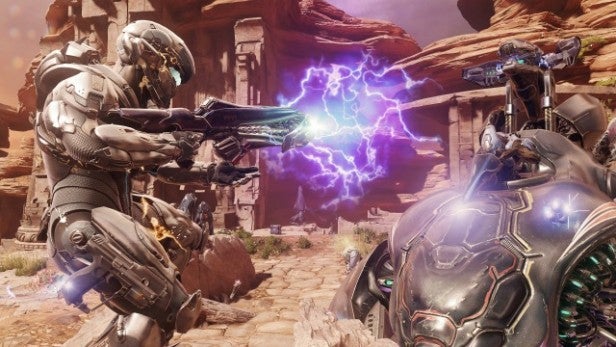
It’s not all old-school, partly because Halo 5 really shakes things up when it comes to movement. Sure, the shoulder barge and ground pound moves are great, but the ever-ready sprint, jet-boost evade and jump-and-grab moves prove transformative, enabling you to speed around maps and create new routes that would previously have been impossible. Halo has always been a skill-focused shooter, but the new movement options add whole new dimensions of show-offery.
The revised approach reaches its apogee with the new Breakout mode, where almost all scenic detail is phased out to deliver streamlined maps with Tron-like visuals, where two teams rush at each other with the aim of capturing the flag or taking out the opposition. It’s quick, deadly and hideously addictive, though I suspect the levels of skill and strategy involved will count a lot of players out in the long run. It’s clearly made for e-sports and likely to become a favourite there. The rest of us will be more than happy with the rest of the Arena modes. I’m not sure when I found a competitive shooter this instantly addictive, but I’m pretty sure it didn’t have Halo in the title.
Warzone is something else. By merging Player v Player and Player v Environment action, 343 Industries has made something really distinctive. On the one hand, the basic setup – large-scale maps, 12-player teams, multiple control points to hold – is nothing unusual, and the maps aren’t as large as Battlefield’s. Titanfall’s Hardpoint mode would be a better point of comparison. What Warzone adds, however, is regular incursions from Covenant and Promethean forces and bosses, where defeating the wave/boss can earn you more points towards the 1,000 winning total than simply holding the objectives.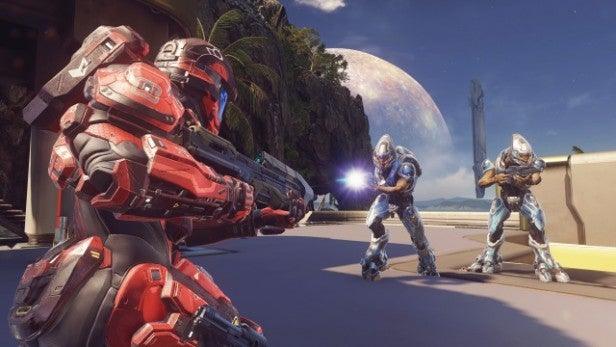
This completely changes the dynamics. Where most modes of this type ask you to prioritise attack or defence and then work out where best to lend your firepower, Warzone demands you keep half an eye on the incoming waves and bosses too, particularly as defeating some of them can transform the whole outcome of the battle. What’s more, there’s the whole requisition system to contend with, where action on the battlefield earns you energy to spend on weapons, armour, perks and vehicles, with the more powerful examples only becoming available as the requisition level rises. This in turn ensures that the action escalates nicely as the battle goes on. You need to think carefully about when you spend your points and what on, making sure you have the best tools for the task at hand. Do you opt for that meaty SAW now and cut a swathe through the opposition, or save up for a Ghost or Mantis later? In fact, are you really sure that you want to risk using and losing the rarer goodies?
The requisition system brings the most potential for controversy, given that requisitions are consumable items you’ll only find in packs, like collectible cards, which you can open between matches. Some packs are simply awarded to you, while others can be purchased using credits earnt in play. Others, however, can be bought with real money in the in-game store. I don’t need to spell out the possible pitfalls, but 343 Industries has handled the unpleasant issue of in-app purchases relatively well. While well-heeled but useless players can buy in better weapons and armour they can’t actually use them without building up energy or until the Req level increases. Meanwhile, more competent players (and even mildly incompetent players like your humble correspondent) can build up a big enough collection without paying to keep themselves in the game. The important thing is that it doesn’t feel unbalanced, and paying up doesn’t feel like a necessary part of enjoying the game.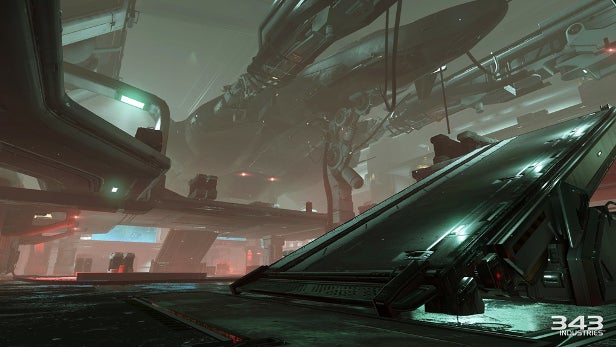
That’s great, because Warzone is fantastic. It doesn’t quite have the maps or the scale to better Battlefield 4 as a large-scale shooter, but it adds something new to Halo that it hasn’t had before. It’s big, exciting and the longer matches give you a game you can really get your teeth into, and a team you can really root for. It’s the kind of mode where you can be knocking on the doors of defeat, only to have a last-minute turnaround and through good, team-focused play see your side triumph. It’s a mode where you’ll thrill as your Spartans group together and go blasting through the enemy ranks to take an objective. If it occasionally makes you wish that 343 could put together a 12 or – better still – 24 player Firefight mode, then it’s only because it does such a good job of making larger-scale Halo combat so enthralling. There’s a bit at the start of the Raid on Apex 7 map that always makes me think of Halo’s Silent Cartographer mission, only this time there’s a whole gang of Spartans ready to do battle, and we’re going to kick some serious Covenant ass.
If Halo 5’s campaign is simultaneously spectacular and mildly underwhelming, its multiplayer more than redeems its failings. You might come for the latest chapter in Master Chief’s saga, but you’ll stay for the compelling co-op and the utterly brilliant competitive modes. They’re good enough to make Guardians essential. 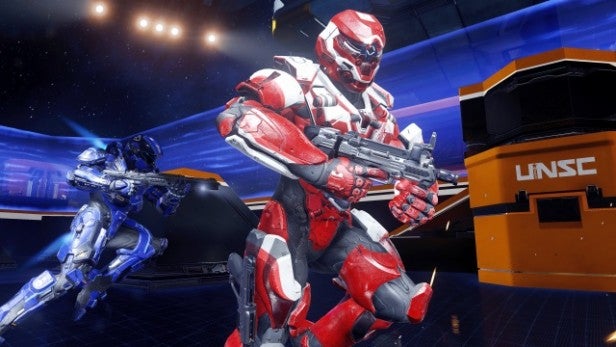
Halo 5: Guardians Initial Review
Of course it’s good. Despite all the ill will generated by Halo: The Master Chief Collection’s matchmaking issues, Halo 4 left us in no doubt that the franchise was in safe hands. Halo 5: Guardians does even more, delivering all the hard-hitting combat and epic sci-fi spectacle we’ve come to expect from a Halo game, while acting as a pretty awesome showcase for what the Xbox One can do when pushed.
There are moments here that will dazzle you, moments that will get your heart pumping, moments that will make you cheer, groan, gasp and chuckle. There’s plenty of fan service and no shortage of artistic vision or technical virtuosity, not to mention the kind of detailed work you only get when you have a colossal budget to spend.
So, yes, Halo 5 is good. The question is: is it genuinely great?
On the levels where most games operate, it is. Here we get two interweaving stories – or perhaps one story told from two perspectives – as the game shifts perspective back and forth between Blue Team, led by the Master Chief, and Team Osiris, led by the ex-ONI agent, now Spartan, Jameson Locke.
The Chief is in search of a certain special someone while Locke is in search of the Chief. In the meantime, the Promethean menace unleashed in Halo 4 is beginning to cause trouble around the galaxy, while the races of the Covenant are embroiled in a messy civil war. For the Halo universe, these are interesting times.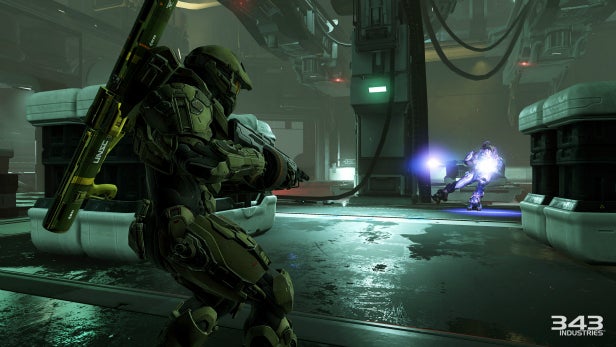
Where Halo 4 stuck to the alien world of Requiem for much of its duration, Halo 5 takes us on a whistle-stop tour of the known and even unknown galaxy, taking us to ONI research stations, remote mining colonies, Covenant homeworlds and Forerunner worlds. We get our share of functional deep-space interiors, but also canyons, ancient temples, caverns and incredibly strange and beautiful alien territory, not to mention exotic, ever-shifting Forerunner monuments that put even those of Halo 4 to shame. If you want to go to interesting places and kill all sorts of interesting extra-terrestrials, then Halo 5 has some of the best.
Wherever you go and whomever you’re playing you’ll always find battle raging, and 343 has pretty much mastered Bungie’s core routine of delivering a string of action bubbles that’s always keeping you moving forward, facing different foes in different situations, working out which approach will work out best.
Not only do you have the Covenant to contend with but also the Prometheans, giving you two sets of enemies, each with distinctive ranks, weapons, styles and behaviours.
Each mission becomes a dizzying series of encounters, shifting between enemy types and even scales to cram in tank battles, aerial assaults, long-range sniper battles, skin-of-the-teeth escapes, fast-moving attacks on entrenched positions and slow, sneaking sections – sometimes in the course of just one mission. It’s expertly paced throughout.
Related: Xbox One vs PS4
There are, of course, new dynamics. For a start, you’re never alone, always part of a four-man team whether you’re playing co-op or single player. Here, Halo 5 plays clever, giving us a co-op friendly take on Halo without forcing in laboured co-op mechanics; you’re just one of four Spartans working together for a common goal. When you’re playing solo your fellow Spartans are controlled by the CPU, but the game treads two fine lines: one between giving the AI some agency and allowing it to dominate the game, the other between having powers to dish out orders and being forced to micromanage.
You never get the feeling, as I have in some instalments of Call of Duty, that you’re the weakest link in a squad of unstoppable bad-asses, yet your comrades can hold their own. The result, you feel like you’re a key part, even the best part, of a squad of unstoppable bad-asses. And while a quick tap designates a target or a position, you can usually let your squad-mates do their thing. Sure, occasionally you may spot them hopping weirdly in front of a slowly opening door, but most of the time they’re totally convincing.
Related: Xbox One tips, tricks and secret features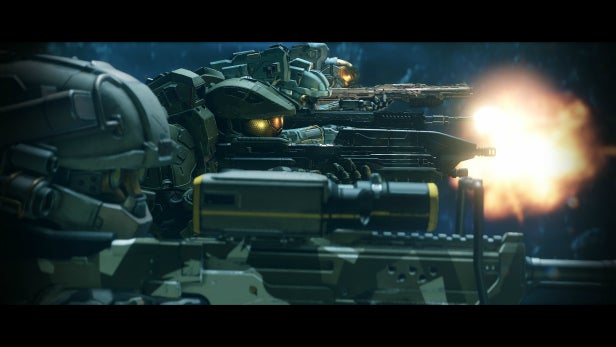
What’s more, your Spartan chums come equipped to get you back on your feet. If your shield is depleted and your health run down, nearby Spartans can revive you. If there isn’t one nearby, pressing X will alert them and bring them to your side. This changes the nature of Halo a little, in that you rarely find yourself dying more than once or twice in any given section, but it gives 343 a little lassitude to throw in enemies or situations that might previously have been too difficult. Best of all, you’re not forced as a solo player to nanny the AI yourself, as downed Spartans will either be revived by your team-mates or will eventually respawn at the next checkpoint – though a risky revival is occasionally worth it if it turns the tide of battle.
Yet the most important role of your Spartan squad-mates is that they add so much character to the game. The constant chatter of the team during battle adds energy to every situation, just as the presence of Cortana did in the Halo games that came before. Weirdly enough, it’s Spartan Locke’s missions that benefit most, partly because Team Osiris benefits from another game-stealing performance from Nathan Fillion as Buck; a cynical, wise-cracking smartass who vies with the grunts for the script’s best laugh-out-loud lines. The grunts actually edge it with their hilarious combinations of dumb bravado, spineless desertion and oddball ruminations, but it really is a close-run thing.
Related: Xbox One HDD Upgrade – How to upgrade your Xbox One storage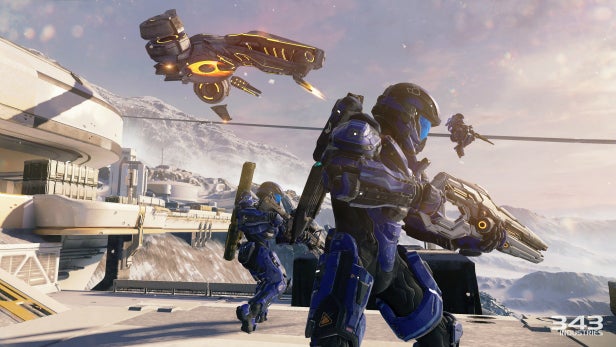
And despite the addition of an iron sights view, Halo 5 isn’t in any danger of changing the nature of Halo’s combat. This is still a shooter from the run-and-gun, shoot-from-the-hip school, where there’s no room for ducking down behind cover and picking off cheap kills, and where a smart, emergent, tactically aware AI makes it a much better idea to keep moving and stay on your toes. In fact, there’s more reason to stay off your toes, too, with a superb new jump and ledge-grab move that makes you much more mobile vertically. Throw in new shoulder barge and ground pound moves and the Spartans have never seemed so superhuman.
Halo is always at its best when it’s forcing you to improvise, making the most of the space available and the weapons you have to hand to rip through the enemy as effectively and spectacularly as possible. Halo 5 is full of those moments, giving you what’s evolved into a superb set of USNC, Covenant and Promethean weapons, with some wonderful new additions, and encounters where you’re pushed to make the most of them. Fans will also be glad to know that there are more large-scale, vehicle-ready sections this time around.
Related: Xbox One backwards compatibility – Can I play Xbox 360 games on my Xbox One?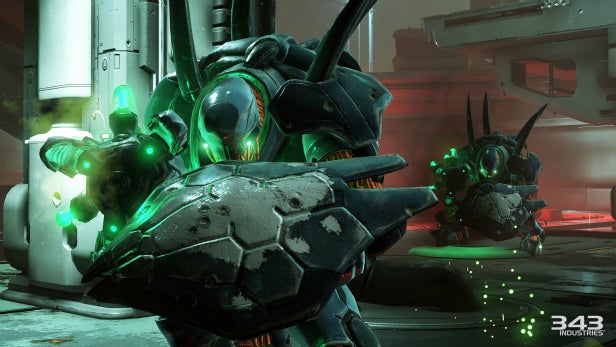
Not everything works perfectly. There’s an absolutely awful section in a mining colony where you can eavesdrop on characters that are supposed to tell you nothing from a distance of two-feet away; a sequence that’s perhaps supposed to remind you of Locke’s background in intelligence, but leaving you wishing 343 had exercised more of theirs. There are two other missions later on where you do almost nothing bar wander somewhere and speak to an important NPC.
These parts don’t just feel unnecessary but positive amateurish, reminding you of nothing more than a second-tier mid-nineties FPS. Meanwhile, a recurring antagonist becomes more irritating with each appearance, with 343 unable to come up with any more interesting way to make him more challenging than simple duplication.
This isn’t major stuff. When it all comes together – which is most of the game – Halo 5 delivers some of the standout set-pieces of the year, leaving you wondering why so few studios can work at this intensity and scale. If I don’t tell you what they are it’s because I don’t want to spoil them for you, but they have to be played to be believed.
In fact, the more I played Halo 5, the more I wondered why anyone ever bothers even thinking about a Halo movie. This is already better than a movie, with more action, more imagination and more verve. Despite the odd slip-up (the mining colony again) it looks unbelievable, cramming so much detail and texture into the scenery, the Spartans and their enemies, then coating it all in gorgeous cinematic lighting. Halo 5 has alien worlds to die for and alien architecture of colossal grandeur and size. The score is practically note-perfect, reaching such a fever-pitch towards the end that you might start to wonder if the end of the world is really nigh.
Related: Xbox One vs Xbox 360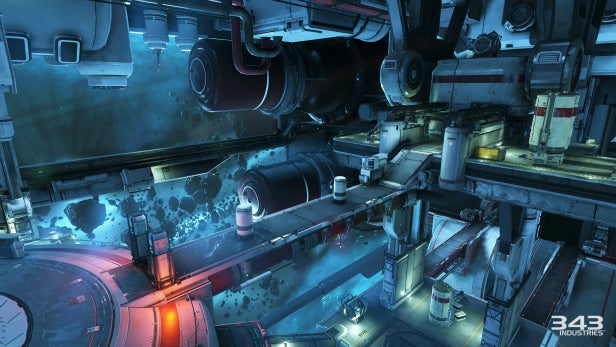
Yet, here’s the thing: if there’s anything that lets Halo 5 down, it’s its most cinematic qualities and, specifically, its storytelling. It reminds me of one of those huge blockbuster films – Avengers: Age of Ultron is a prime example – that’s full of great action scenes and great character moments, but doesn’t quite hang together as it should. Small but significant scenes seem to have been dropped, while revelations that should have been world-shattering seem to be absorbed by the characters as if they knew all about them already, but couldn’t be bothered to explain them properly to you. There’s both too much exposition and, paradoxically, not enough where it counts.
And even when the tale is being told with real skill, a strong script and good acting, I’m not sure I buy the direction that Halo 5 takes the series in. I won’t say much for fear of spoilers, but I think it’s going to be a divisive and – for some of us – not so satisfying path.
Related: Xbox One FAQ – Everything you need to know about the Xbox One
Of course, the campaign is only one part of the package, but with limited time and a restricted playlist pre-release, it’s far too early to say anything too definitive about the multiplayer portion. What is clear is that Arena mode sees Halo stripped-back and retooled for the e-Sports era, featuring simpler maps, shorn of detail and clutter, carefully tuned flow and weapon placement and modes designed to up the pace, challenge skills and deliver spectacle.
The approach reaches its apogee in the new Breakout mode, with its Tron-like visuals and tense four-on-four, no respawn battles, but you can see it across Slayer, CTF and Stronghold too. The downside is that it can be unforgiving of newbies or the useless – which is where 343 really needs to get the matchmaking right this time – but the upside is that it’s incredibly addictive. There’s a Doom/Quake/Counter-Strike vibe to Arena mode that’s very appealing.
With less experience we’re even less inclined to say much about Warzone, except that it’s mix of large-scale Battlefield-style warfare and almost Destiny-like co-op skirmishes and boss-battles has a lot of promise, with the action escalating nicely as new weapons and vehicles become available through the requisition system. We’ll cover both Arena and Warzone in more depth, and look at server and matchmaking stability, in an update after launch (SEE ABOVE).
Verdict
So, back to the original question: Halo 5 is definitely good, but is it great? Well, I’m tempted to err on the side of greatness.
It’s superbly paced, endlessly spectacular and has some of the best set-pieces and moments of any Halo game. Yet for me it doesn’t reach the same dramatic heights of Halo 3 or Halo 4, and I can’t help feeling that the storyline doesn’t 100 per cent convince. It’s a game of immense shock and awe, laced with real humanity and humour, yet it can be clumsy and lacking in soul.
The exceptional high points and brilliant multiplayer make it a must-play for just about anyone with an Xbox One, but it’s going to be a long time before we’ll know if 343 has made the right choices here or taken Halo down a path that’s best not travelled.

